Filleted Route Buenos Aires, a tour to enjoy the artistic lines and typical ornaments of the city’s tradition.
As you may have noticed, Buenos Aires has an enormous cultural tradition that embellishes it and makes it stand out from the rest of the cities. Without hesitation, the field of art is not left out of this, and that is why we put together a tour so that you can do it on foot, enjoying the Art of typical Filleted, while, at the same time, you can know some more neighborhoods.
Here we tell you much more about this style of art so characteristic of Buenos Aires, closely related to Tango and by the way, know what these drawings so repeated around the city are about.
We are going to visit the neighborhoods of San Telmo, La Boca, Boedo and Almagro, since they are the spaces that best preserve this outstanding and autochthonous art, as well as being where these details abound. If we stop to meditate for a second, they are also the spaces where Tango is breathed the most in the city!
Now yes, let’s start the road to our Filleted Route!
 We are going to start by enjoying an exquisite coffee at the La Perla bar, which is located on the well-known and traditional corner of Caminito. It is an old bar that keeps alive the most outstanding and typical essence of old Buenos Aires. Both its sign, as well as the false obelisk at the entrance and the posters of Carlos Gardel and Aníbal Troilo, are the works of Sergio Menasché, the most important and well-known national filleter. After delighting your eyes with the decoration and the details, enjoying the delicious coffee, we will continue on our way a few meters from this place.
We are going to start by enjoying an exquisite coffee at the La Perla bar, which is located on the well-known and traditional corner of Caminito. It is an old bar that keeps alive the most outstanding and typical essence of old Buenos Aires. Both its sign, as well as the false obelisk at the entrance and the posters of Carlos Gardel and Aníbal Troilo, are the works of Sergio Menasché, the most important and well-known national filleter. After delighting your eyes with the decoration and the details, enjoying the delicious coffee, we will continue on our way a few meters from this place.
We continue to the Benito Quinquela Martín Museum of Fine Arts, where you will be able to visit the former home of this famous artist. Obviously, his atelier is located here, donated by Quinquela, with brushstrokes similar to traditional Buenos Aires filleting. One of its rooms exhibits figureheads that contain representative shapes of the wind and waves, together with mythological figures that ensured the safety and well-being of men on the high seas.
 Leaving this Museum, we will walk through the beautiful space of Caminito in La Boca, turning to the right, to arrive at the Marjan Grum Conventillo Museum. Recognizing it will be easy for you since its façade exposes a huge mural painted by Menasché, with a pure filleting technique. The owner of this place is Beatriz Corvalán, a great painter who requests that you make a prior appointment to enter the Museum. She is the one who is going to show you the facilities and objects of the filleting, as well as showing you and telling you about the different works that are in the sample.
Leaving this Museum, we will walk through the beautiful space of Caminito in La Boca, turning to the right, to arrive at the Marjan Grum Conventillo Museum. Recognizing it will be easy for you since its façade exposes a huge mural painted by Menasché, with a pure filleting technique. The owner of this place is Beatriz Corvalán, a great painter who requests that you make a prior appointment to enter the Museum. She is the one who is going to show you the facilities and objects of the filleting, as well as showing you and telling you about the different works that are in the sample.
We will continue our way through the La Boca neighborhood (here we tell you everything you can do in this neighborhood), and we will move towards San Telmo. Here, you will be able to get closer to the Association of Filleters of Buenos Aires, which is the space where experts meet, workshops are held and there are various exhibitions that will catch your attention. It is an organization that was born in 2012 to be able to disseminate this national art.
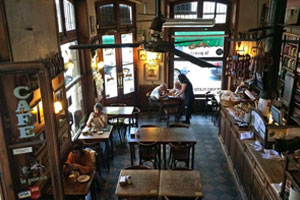 A few blocks from the Association, five to be precise, going to the center of the city, we will arrive at Café La Poesía, one of the most famous in San Telmo. It is a coffee that is located within the Notable Bars of the city, so its imprint is very prominent. Before entering here, do not miss admiring the huge mural of fillets that it has in the eighth in front. It is a tribute to Leonardo Favio, who was a famous national film director. For this instance, you will be able to enjoy a delicious lunch to follow the path to Michelangelo’s Filleting Workshop, where you can enjoy a class in case you come here on a Saturday, or buy some works. If you go on a Sunday, a great option is to visit the Plaza Dorrego Fair, where you could find Alfredo Martínez, a prominent filleting artisan. Here we tell you more about what you can do in San Telmo!
A few blocks from the Association, five to be precise, going to the center of the city, we will arrive at Café La Poesía, one of the most famous in San Telmo. It is a coffee that is located within the Notable Bars of the city, so its imprint is very prominent. Before entering here, do not miss admiring the huge mural of fillets that it has in the eighth in front. It is a tribute to Leonardo Favio, who was a famous national film director. For this instance, you will be able to enjoy a delicious lunch to follow the path to Michelangelo’s Filleting Workshop, where you can enjoy a class in case you come here on a Saturday, or buy some works. If you go on a Sunday, a great option is to visit the Plaza Dorrego Fair, where you could find Alfredo Martínez, a prominent filleting artisan. Here we tell you more about what you can do in San Telmo!
A few meters from San Telmo, towards the Monserrat neighborhood, you will find the Bar del Filete, which is part of the City Museum. This site has its walls riddled with fillets, works that were carried out by Nicolás Rubió and Esthel Barugel, who in the 60s were the pioneers of the Filet Show, prior to being recognized as an icon of Buenos Aires. Just a few blocks away, you can visit Café Tortoni, famous for its tradition, known as the Tango Headquarters, of exquisite breakfasts and snacks, as well as having a beautiful cash register completely decorated with traditional fillets.
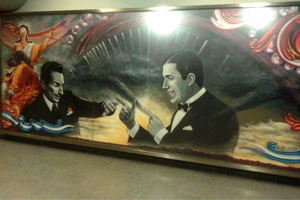 At this point, we are going to make a parenthesis of the walk to tell you that, if you are tired, you can continue the journey by public transport. Ideally, you should use the H Line Subway, going to Corrientes Station to enjoy the portraits of Enrique Santos Discépolo and Carlos Gardel. These designs are the creation of two recognized masters of this art: Jorge Muscia and Alfredo Martínez. From here, you can combine with Line B to Carlos Gardel Station, where you will find another mural by León Untroib.
At this point, we are going to make a parenthesis of the walk to tell you that, if you are tired, you can continue the journey by public transport. Ideally, you should use the H Line Subway, going to Corrientes Station to enjoy the portraits of Enrique Santos Discépolo and Carlos Gardel. These designs are the creation of two recognized masters of this art: Jorge Muscia and Alfredo Martínez. From here, you can combine with Line B to Carlos Gardel Station, where you will find another mural by León Untroib.
But, if you don’t want to use the subway, don’t worry, there aren’t many more blocks to go!
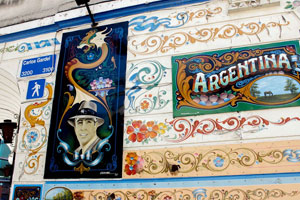 Once you have arrived at the Carlos Gardel Station, or walking to the Almagro neighborhood, you will find the Casa Carlos Gardel Museum. This space is an open-air display of the entire Fillet style in large dimensions. Six houses on this site have figures such as national flags, five-petal flowers, dragons and swans, all interventions that have been carried out since 2004. They were organized by a contest of “El Abasto y el Fileteado Porteño”, from the hand of Alfredo Genovese.
Once you have arrived at the Carlos Gardel Station, or walking to the Almagro neighborhood, you will find the Casa Carlos Gardel Museum. This space is an open-air display of the entire Fillet style in large dimensions. Six houses on this site have figures such as national flags, five-petal flowers, dragons and swans, all interventions that have been carried out since 2004. They were organized by a contest of “El Abasto y el Fileteado Porteño”, from the hand of Alfredo Genovese.
Leaving the Almagro neighborhood, we will walk a few blocks to Boedo Avenue to reach the corner of San Juan and Boedo, which you will hear called the Homero  Manzi Corner, since this famous bar is located here. Wherever you look at a traditional site, it has an endless number of ornaments and details of typical filleting inside. Just two blocks from here, you can enter the wonderful traditional world of Café Margot. This place is also part of the Notable Bars program, it is a typically Buenos Aires space, known for its exquisite turkey sandwich. But don’t worry, their menu is much more extensive and for all tastes! Also, it’s one of the few places that has cider on tap and the craft beers are really good. Once you have enjoyed this beautiful Café that is worth visiting, we will continue walking along Boedo Avenue, where you will be able to see approximately 40 plates that were made by Luis Zorz with delicate filleting details in homage to various historical places. In this link, you will be able to know everything you can do in the Boedo neighborhood.
Manzi Corner, since this famous bar is located here. Wherever you look at a traditional site, it has an endless number of ornaments and details of typical filleting inside. Just two blocks from here, you can enter the wonderful traditional world of Café Margot. This place is also part of the Notable Bars program, it is a typically Buenos Aires space, known for its exquisite turkey sandwich. But don’t worry, their menu is much more extensive and for all tastes! Also, it’s one of the few places that has cider on tap and the craft beers are really good. Once you have enjoyed this beautiful Café that is worth visiting, we will continue walking along Boedo Avenue, where you will be able to see approximately 40 plates that were made by Luis Zorz with delicate filleting details in homage to various historical places. In this link, you will be able to know everything you can do in the Boedo neighborhood.
Undoubtedly, it is an excellent plan to learn more about the city, its tradition and this wonderful typical Buenos Aires art.
To learn more about Buenos Aires, we invite you to join our Free Tours here!
Find out what you can do in Buenos Aires by following this link.

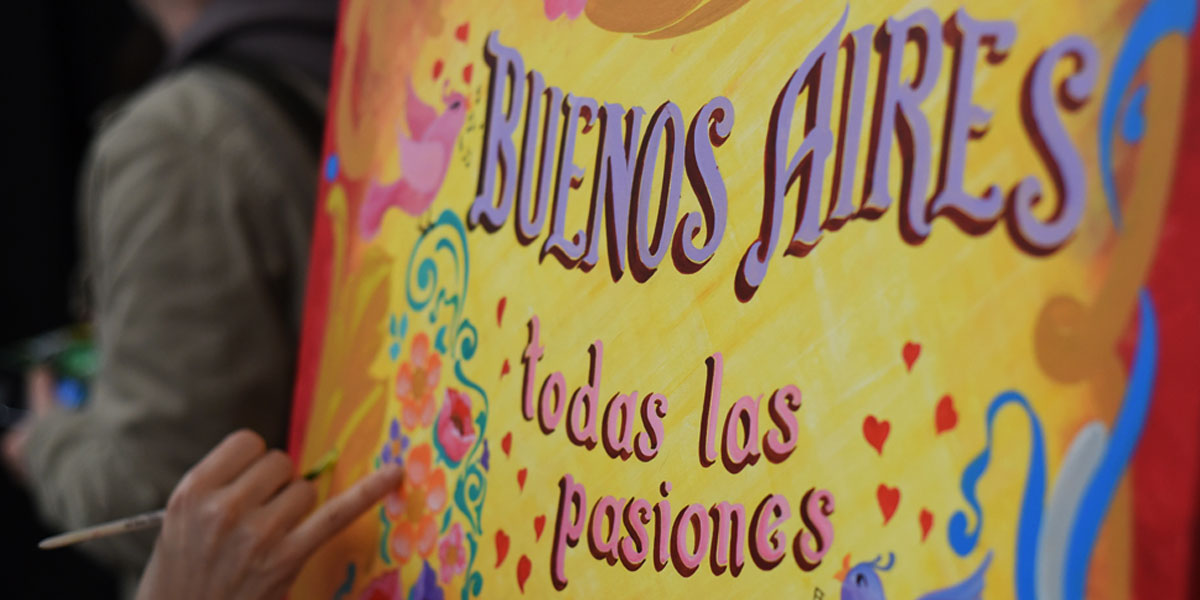

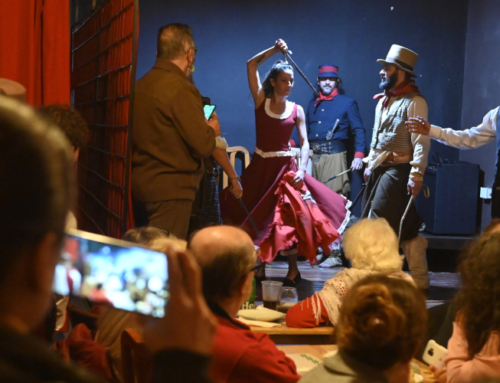

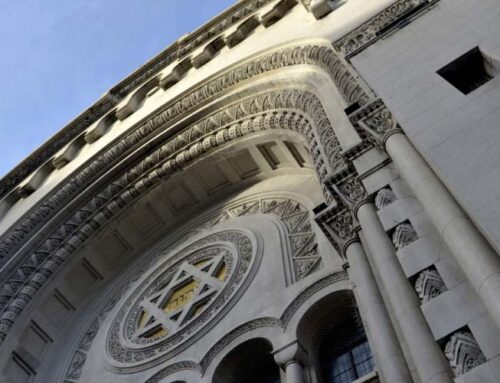
Leave A Comment